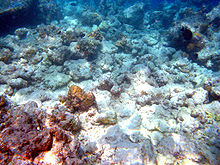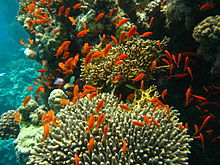Coral bleaching
Coral bleaching refers to the bleaching of stony coral canes, which can lead to the subsequent death of the coral.
Corals are living organisms. They belong to the cnidarians and settle in symbiosis with photosynthetically active protozoa (zooxanthellae) on a limestone layer that grows from year to year. If the zooxanthellae are rejected by the coral, the coral loses its colorfulness. This phenomenon can occur locally, but also over a large area and is called coral bleaching. It occurs mainly when water temperatures are too high.
Next to rainforests, coral reefs are considered to be the most species-rich habitats in the world: So far, about 60,000 different species have been discovered here. However, more than 400,000 species are thought to live in the reefs, e.g. more than a quarter of all known marine fishes live here. The size of all reefs is estimated at over 600,000 km². Coral reefs have existed for over 225 million years, making them some of the oldest known ecosystems in the world.
Both with their richness of species, especially fish, and as a tourist diving and snorkelling attraction, they are a source of food and income for large parts of the people living on the respective coasts. By being able to absorb 70 to 90 % of locally occurring wave energy, they protect the respective coasts not least from mechanical stress and destruction by waves.
In the course of man-made global warming and the permanent warming of the oceans that goes hand in hand with it, the frequency and intensity of bleaching events is increasing; above all, the period of at least about 10 years that is necessary for a possible recovery of the reefs is being lost. Even with the now probably unavoidable global warming of 1.5 degrees, the World Biodiversity Council IPBES expects that 70 to 90% of the corals will be lost, at two degrees it would be 99%: Only adapted coral remnants could survive.
Coral bleaching in combination with other stressors such as ocean acidification or inputs of pollutants or trace substances, especially nitrogen or phosphorus, increases the mortality of corals worldwide: large-scale coral bleaching can be the cause and visible sign of mass coral mortality.
For many coral reefs, a tipping point is in danger of being passed, beyond which they will be irretrievably lost.

Dead stony corals

Healthy stony corals
Bleaching Process
Stony corals live in symbiosis with zooxanthellae, which are also responsible for the coloration of the corals. The zooxanthellae live endosymbiotically in the cells of the coral polyps. They are able to eliminate pollutants in the cells of the polyps like a kind of kidney, but above all they carry out photosynthesis and supply the corals with glucose, glycerol and amino acids. Although corals are also filter feeders, i.e. they filter microplankton from the seawater, in the nutrient-poor warm tropical waters the supply of photosynthetically formed nutrients is essential for them; their share of the total nutrient supply can be up to 90 % (→ reef paradox).
This symbiotic relationship is sensitive to a number of stressors, including regional, such as various environmental toxins, excessive solar radiation or an abrupt change in the salinity of the seawater, and global, especially heat stress. Zooxanthellae begin to lose their ability to photosynthesize when the temperature of the seawater is too high - in the species Oculina patagonica, for example, the threshold is 29° Celsius (→ photoinhibition). This leads to oxidative stress, which has a toxic effect on the host cells. As a result, the zooxanthellae are rejected by the corals, which also lose their coloration and "bleach out". Some corals look after bleaching, instead of chalky white, also pastel blue, yellow or pink, cause for this are proteins formed by the corals.
The exact temperature threshold at which this disassociation of coral and zooxanthellae occurs depends, among other things, on the species involved. Particularly fine-branched corals are susceptible to higher temperatures, including Seriatopora, Stylophora, Pocillopora, Acropora and Montipora. More resistant massive genera include Porites or Goniopora. There is also a great diversity of species among zooxanthellae, often zooxanthellae belonging to different clades are found in the same coral species. Heat-tolerant zooxanthellae are found mainly in the very warm Persian Gulf, whereas the neighbouring cooler Red Sea is home to more sensitive species. The extent to which the type of zooxanthellae influences the nutrient supply, growth or heat resistance of the community is the subject of research.
Recent studies show that the availability of nutrients, especially nitrogen and phosphorus, also has an important influence on symbiosis. In a reef near the Florida Keys, a major cause was human nitrogen input, such as from washed-out fertilizer or sewage, into the seas. A disturbed phosphorus-nitrogen ratio probably made the corals susceptible to thermal stress.
Without zooxanthellae, corals cannot survive permanently. They die if the zooxanthellae do not return within a period of about eight weeks (the exact period is species-specific).
After bleaching, coral reefs may be able to regenerate through repopulation. For certain corals this is possible within 10 to 15 years, for old reefs this process takes many decades. During this process, no further coral bleaching or other further disturbance of the recovery phase should occur. Factors such as water pollution, overfishing and disease slow down the recovery of coral reefs.
Causes
Due to man-made global warming, there is also a permanent warming of the oceans worldwide. As a result, entire reefs can fall victim to coral bleaching and die over large areas. Furthermore, the increased water temperatures not only lead to coral bleaching, but also reduce the reproductive capacity of the surviving corals.
In the Pacific, for example, exceptionally high water temperatures also occur in the wake of the El Niño weather phenomenon: the coral bleaching observed here in 2016 was the most severe observed to date: 55% of the reefs were severely damaged, compared to only 18% in the two previous bleaching events in 1998 and 2002. Overall, 93% of all reefs were affected in 2016. If bleaching continues for a long period of time, the reefs die.
As global warming and the associated warming of the oceans continue, the frequency, intensity and duration of periods of unusually high sea temperatures are increasing (→ marine heatwave); the frequency of years with heat stress has increased significantly: 40 years ago, the probability of their occurrence was once every 25 to 30 years; now (2019) it has reached once every six years. As a result, the period between two coral bleaching events is becoming too short for recovery in an increasing number of regions. The frequency and intensity of bleaching events is increasing, although - possibly as a result of the death of particularly temperature-sensitive coral species - bleaching has tended to occur only at higher water temperatures since the 2000s. If greenhouse gas concentrations in the Earth's atmosphere continue to rise, all reefs worldwide could be affected by at least one bleaching event per decade by the end of the century. Thus, if coral reefs are to continue to exist in the future, action is needed to rapidly limit global warming.
The continuing and increasing worldwide acidification of the oceans, also in the wake of man-made global warming or the rising CO2 concentration in the atmosphere, is making it more difficult for coral shells and skeletons to form calcium carbonate: about 1/3 of the additional carbon dioxide contained in the Earth's atmosphere is absorbed by the oceans, where carbonic acid is formed; the pH of seawater has already fallen on average from 8.25 to 8.1, which is equivalent to an increase of more than 25%. The average acidity of seawater threatens to fall to about 7.5 by 2100 unless strong climate action is taken.
According to NOAA, the US National Oceanic and Marine Administration, approximately 4,000 to 6,000 tons of sunscreens enter coral reefs each year: Their input, especially with the chemicals oxybenzone, octocrylene and parabens contained in them, which protect humans from UV radiation, into the water at coastal bathing beaches and "diving and snorkelling paradises" has also been identified as promoting coral bleaching; the Pacific island state of Palau banned sunscreens containing the aforementioned active ingredients from 1 January 2020 due to the potential for damage even in small quantities; in May 2018, the US state of Hawaii already decided to ban sunscreen from 2021. Octocrylene is contained in four out of five European sunscreen products.
In October 2020, a metagenomic analysis was published that postulated a link between coral bleaching at Mo'orea, French. Polynesia and viruses. Although a clear assignment of the reconstructed "assembled coral giant virus" to a specific representative of the giant viruses from the group of NCLDV (Phylum Nucleocytoviricota) was not possible, according to the authors, an affiliation to these is out of the question. However, further investigations are necessary. The virus was found in both bleached and apparently healthy corals.
Questions and Answers
Q: What is coral bleaching?
A: Coral bleaching is when stony corals turn white due to changes in their environment, such as warmer sea water temperatures caused by global warming.
Q: What is the leading cause of coral bleaching?
A: Warmer sea water temperatures caused by global warming is the leading cause of coral bleaching.
Q: How much of a coral's energy does the algae provide?
A: The algae provides up to 90% of the coral's energy.
Q: How much damage was done to the Great Barrier Reef in 2016?
A: In 2016, bleaching of coral on the Great Barrier Reef killed between 29 and 50 percent of the reef's coral.
Q: How often do global bleaching events occur?
A: The interval between bleaching events has halved between 1980 and 2016.
Q: What colors can some corals change into when they are being bleached?
A: Some corals change color instead of turning white when they are being bleached, with colors ranging from very bright hues.
Q: Why do some corals change color during a bleach event? A: Scientists from the University of Southampton have suggested that these bright colors act like sunscreen and protect the coral cells from light, making it easier for algae to come back and stay alive until then.
Search within the encyclopedia